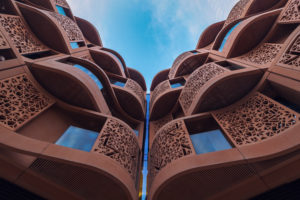Green architecture builds resilience in low income communities
Many cities across the world are beginning to feel the impacts of climate change. Some struggle with a rising sea level and flooding, while others suffer to work through extreme heat and expanding deserts. However, the use of green architecture can help create a healthier and more sustainable living environment for cities struggling with the effects of climate change. In an effort to reduce its dependence on fossil fuels, developers in the UAE have created two sustainable neighborhoods. The buildings of Masdar City, which is 10 miles outside of Abu Dhabi, are lifted a few feet above the ground to harness the natural breeze and circulate it throughout the structures. The Sustainable City, which is 18 miles outside of Dubai, has nearly 32,300 square feet of outdoor urban farms and 11 greenhouses, offering not only better air quality but an opportunity to grow one’s own fresh vegetables in a desert climate where they may not be readily accessible. These efforts not only reduce the usage and costs of energy in the long run, but help prevent the deadly effects of urban heat islands, which can drive temperatures up by 10-15 degrees.

While sustainable housing and green architecture may seem to be reserved for the wealthy, cities can utilize these practices in low-income communities to help make them more resilient. Though beautiful, the UAE’s models of a “sustainable” city may not be sustainable for everyone. Villas in the Sustainable City go for $1 million USD, and each unit in Masdar’s apartment buildings are estimated to cost roughly $440,000 USD – respectively nearly 13.5 times the median income of the country. However, many of the practices in the cities can be used in urban planning to help mitigate some of the effects of climate change. At their heart, both of these practices can be altered to fit the needs of different communities.
The Bronx, New York was able to effectively blend green architecture with the demands of public housing, instilling resilience into the neighborhood. The Via Verde in the South Bronx offers co-ops for low and moderate income residents in an energy-efficient and visually pleasing apartment complex. After rounds of community engagement, a complex was designed that not only functioned on clean energy sources, but with the mindset of a healthy lifestyle for the community. In a neighborhood where asthma rates are high and fresh produce is difficult to find, residents were eager to have a healthy and sustainable living space. The complex functions on clean energy, which is proven to help households save up to 22% of their incomes in the long term. Designed with a narrow building footprint, each apartment is provided with two outside exposures for cross ventilation and a ceiling fan to cool each apartment naturally, similar to the architectural goals of Masdar City. Additionally, the complex’s terrace is complete with communal garden plots and fruit trees, designed to encourage residents to grow their own produce and reduce air pollution, resembling the vast urban farms of the Sustainable City. Green architecture and sustainable housing can offer low-income families access to renewable energy and healthier lifestyles, creating a more resilient community in the face of climate change.
Sources and Additional Reading
Lifegate – What is sustainable architecture: definition, concept and famous examples
ArchDaily – Inside Masdar City
Business Insider – The United Arab Emirates is building a $354 million city with driverless cars, greenhouses, and solar-powered villas
The Global Resilience Institute – Heat island effects show intersection of social and environmental resilience
The Guardian – Masdar’s zero-carbon dream could become world’s first green ghost town
New York Times – In a Bronx Complex, Doing Good Mixes With Looking Good
EPA – Smart Growth and Affordable Housing
